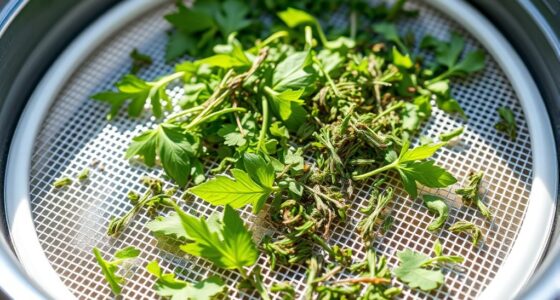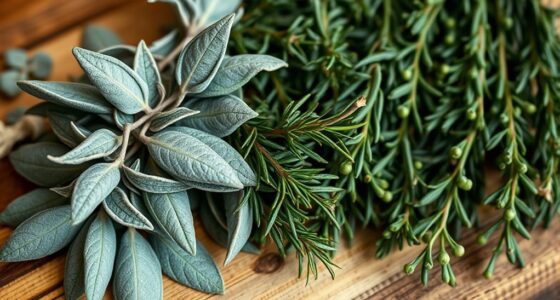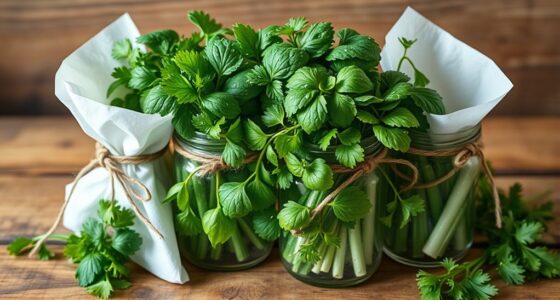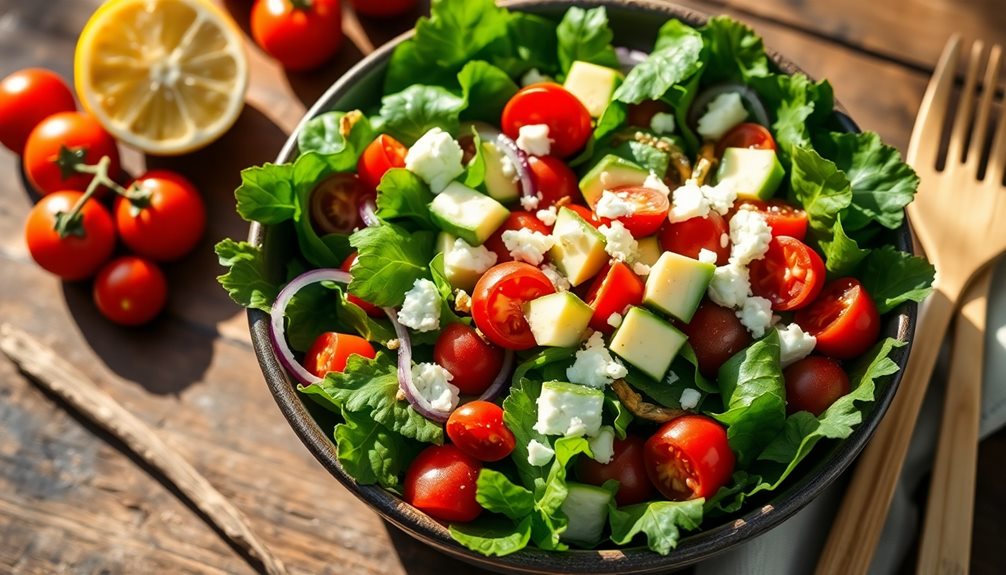Building a Caribbean spice garden on your windowsill is simple and rewarding. Choose sunny spots with 4-6 hours of direct light, and use small pots with drainage holes filled with quality potting soil. Grow herbs like thyme, cilantro, ginger, and turmeric for fresh flavor, health benefits, and sustainable cooking. Regular watering and pruning encourage healthy growth. Keep exploring for more tips to guarantee your spice garden thrives and adds authentic Caribbean flair to your home.
Key Takeaways
- Choose sunny windowsill locations with 4-6 hours of direct sunlight for optimal herb growth.
- Select small pots with drainage holes and fill them with high-quality potting soil suitable for herbs.
- Plant Caribbean herbs like thyme, cilantro, ginger, and turmeric, and water regularly without overwatering.
- Prune herbs frequently to promote bushier growth and prevent legginess, ensuring a healthy, productive garden.
- Use your homegrown spices and herbs in cooking and herbal remedies, boosting flavor and wellness year-round.
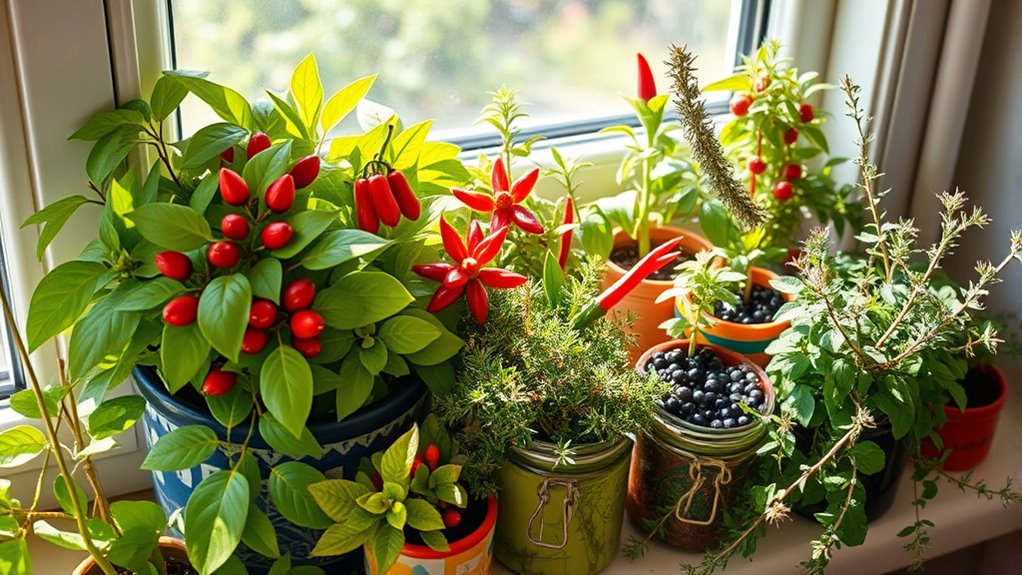
If you’re craving the vibrant flavors of the Caribbean but lack outdoor space, growing a spice garden on your windowsill is a perfect solution. Not only does it bring tropical zest into your home, but it also offers a range of practical benefits. Many Caribbean spices, like allspice, ginger, and turmeric, are valued not just for their bold flavors but also for their herbal medicine properties. By cultivating these herbs indoors, you can easily incorporate them into your daily routines, enhancing both your meals and your health.
Starting your windowsill spice garden is straightforward. Choose a sunny spot where your plants will get at least four to six hours of direct sunlight each day. Use small pots with drainage holes to prevent waterlogging, and fill them with good-quality potting soil. Many Caribbean herbs, such as basil, thyme, and coriander, thrive in these conditions. You’ll want to water them regularly but avoid overwatering, as their roots need oxygen to stay healthy. As your plants grow, you can prune them to encourage bushier growth and prevent them from becoming leggy. Additionally, understanding the specific needs of each herb can help optimize their growth and flavor profile.
Choose a sunny spot, use drainage pots, and water regularly for thriving indoor Caribbean herbs.
Culinary uses are the most immediate reward of your spice garden. Fresh herbs like thyme and cilantro can elevate everyday dishes, adding authentic Caribbean flavors to soups, stews, and marinades. Spices such as allspice berries or dried ginger can be ground into powders to season meats, vegetables, or even baked goods. Growing your own herbs ensures you always have fresh ingredients at hand, which is especially valuable when preparing traditional Caribbean dishes like jerk chicken or curried vegetables. Plus, harvesting your own spices promotes sustainable cooking and reduces reliance on store-bought alternatives that may contain preservatives or additives. Incorporating sustainable practices into your gardening routine can further enhance the environmental benefits of your indoor spice garden.
Beyond flavor, many of these herbs and spices offer herbal medicine benefits. Ginger, for example, helps with digestion and inflammation, while turmeric is renowned for its anti-inflammatory properties. Growing these plants indoors means you can easily harvest and prepare herbal infusions, teas, or topical remedies. This makes your windowsill garden a living pharmacy, providing natural remedies that you can incorporate into your wellness routine. The controlled environment of your indoor garden also allows for year-round cultivation, ensuring a continuous supply of these beneficial herbs. As you tend to your plants, you not only nurture your culinary creativity but also cultivate a small, personal apothecary. Incorporating practices like mindfulness during gardening can enhance your connection to the process and promote mental well-being. Knowing the science behind plant growth can help you troubleshoot issues and maximize your garden’s health.
Incorporating Caribbean spices into your windowsill garden allows you to enjoy authentic flavors and health benefits without needing outdoor space. With a little care and attention, your indoor garden becomes a vibrant, functional part of your home, offering fresh herbs for cooking and herbal medicines for your well-being. It’s a simple way to bring the Caribbean’s rich culinary and herbal traditions into your everyday life, no matter where you live.
Frequently Asked Questions
Can I Grow All Caribbean Spices Indoors Year-Round?
You can grow many Caribbean spices indoors year-round, but not all. Some spices thrive continuously, while others may need seasonal spice harvesting or specific conditions. To keep your spices fresh, learn spice drying techniques to preserve flavors. Make certain your windowsill gets enough sunlight, and adjust watering as needed. While some herbs like thyme and basil grow well indoors, others might require outside growth or specific seasons for ideal harvest.
Which Spices Are Most Suitable for Small Windowsills?
For small windowsills, choose compact herbs like thyme, oregano, and basil. These spices thrive in limited space and sunlight. To guarantee the best flavor, use proper herb drying techniques once harvested, and store your spices in airtight containers. Remember, spice harvesting tips include snipping leaves early in the morning and avoiding overwatering. This way, your windowsill garden remains vibrant, and your spices stay fresh and flavorful year-round.
How Often Should I Water My Spice Plants?
Wondering when to water your spices? Your watering schedule depends on factors like plant hydration needs, pot size, and indoor conditions. Generally, check the soil’s moisture—if it’s dry an inch below the surface, it’s time to water. Usually, watering once or twice a week suffices, but adjust based on humidity and temperature. Consistent care helps your spice plants thrive and stay healthy, so observe and respond accordingly.
Do Caribbean Spices Require Special Soil or Fertilizers?
Caribbean spices generally don’t need special soil, but they do thrive with rich soil nutrients. Use a well-draining potting mix and add organic compost to boost nutrients. Fertilizer types like balanced liquid fertilizers or slow-release pellets work well; just follow the label instructions. This guarantees your spices get enough nutrients without overfeeding, helping them stay healthy and flavorful. Regular feeding promotes vibrant growth and better spice yields.
How Do I Prevent Pests From Damaging My Spice Garden?
To prevent pests from damaging your spice garden, start by choosing pest-resistant plants, which naturally ward off common invaders. Keep your garden healthy with proper watering and good airflow, reducing pest attraction. Use natural pest control methods like neem oil or insecticidal soap when needed, and regularly inspect your plants for early signs of trouble. These strategies help protect your spices without harmful chemicals, ensuring a thriving, pest-free garden.
Conclusion
Growing a Caribbean spice garden on your windowsill isn’t just rewarding; it connects you to vibrant flavors and cultures. Did you know that over 70% of the world’s spices come from small-scale farmers in the Caribbean? By cultivating these herbs yourself, you’re supporting sustainable farming and bringing bold, authentic tastes into your home. So, start planting today—you’ll not only spice up your meals but also nurture a piece of the Caribbean’s rich heritage right at your windowsill.


